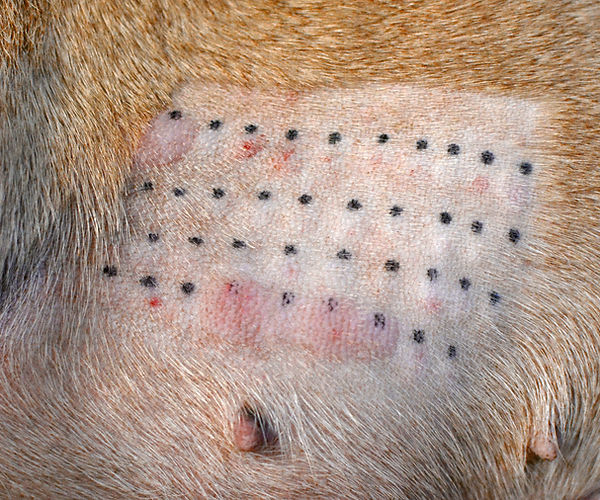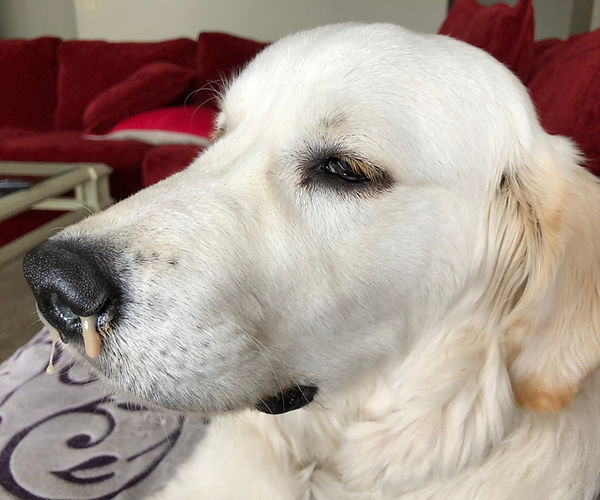
Gesundheit! The medical term for a runny nose is rhinitis, and rhinitis can be classified as either mild or severe, and periodic or chronic [1]. Although it is normal for healthy dogs to have a slightly runny nose, more severe nasal discharge may indicate a serious medical condition. A pet owner can identify mild runny noses by a slight watery discharge and some sneezing, whereas a severe runny nose lasts longer and has a gooier, opaque discharge [1].
Symptoms characteristic of rhinitis include nasal discharge, sneezing, snoring, open-mouth breathing, and/or labored breathing [2]. Coloration in the mucus may occur due to microbial infections, with sneezing frequency increasing as an attempt to clear upper airways of discharge [2]. While more serious conditions such as tumors may cause rhinitis, the most common causes of your dog’s runny nose range from allergies, to sinus and oral infections. Consequently, understanding the possible sources of your dog’s runny nose and how it manifests is critical for effective treatment. It is important to underscore that while this article is going to focus on three common causes of canine rhinitis, there are several other diseases that may contribute to your dog’s runny nose and necessitate immediate interventions. Visiting a veterinarian if you suspect your dog is sick is always recommended.
And so without further ado, here are three common reasons your furry friend is suffering from a runny nose!
1. Allergies
As one of the most common causes for runny noses in dogs, allergies are a set of complex immune reactions involving the release of histamines when the immune system is exposed to an allergen [3]. Histamines can cause inflammation, redness, swelling, runny noses, and/or sneezing. In dogs, the three leading causes of allergies are flea bites (6.82%), atopic dermatitis (10-15%), and food allergies (1-2%) [3]. Furthermore, allergic reactions are particularly troublesome for dogs because the irritation and possible itching leave the canine susceptible to secondary infections. For example, dogs with allergic dermatitis frequently have concurrent skin and ear infections, with these dogs having higher rates of Staphylococcus spp. on their skin [4]. Malasezzia yeast infections may also arise as a consequence of canine allergies [3]. Atopic dermatitis is often caused by environmental factors that include direct contact with an animal, object, plant, irritating chemical substance, or more [3]. Dust, pollen, and mold are common culprits. Oftentimes these allergies are seasonal, with peaks occurring in the spring and fall.
Various breeds are predisposed to developing allergies in their lifetime, and include but are not limited to:
- Chinese Shar-Peis
- Terriers
- Golden Retrievers
- Dalmatians
- Boxers
- Shih Tzus
- Lhasa Apsos

The image above depicts immune response results of a dog’s intradermic skin allergy test performed for medical diagnosis of allergies on a dog.
2. Infection in your dog’s sinus
Viral infections are the leading cause of acute canine rhinitis, with canine distemper, canine adenovirus types 1 and 2, and canine parainfluenza most often being the source [2]. Secondary, opportunistic bacteria can also invade a dog’s respiratory system, further complicating your pet’s ability to breathe properly.
Advances using Next-Gen Sequencing (NGS) technology have allowed researchers to find that Moraxella spp. predominantly colonizes the nasal cavity of dogs suffering from chronic lymphoplasmacytic or neutrophilic rhinitis [5]. By contrast, the nasal cavity of healthy dogs has a higher species richness and lower abundance of Moraxella spp. Bordetella bronchiseptica can cause infectious tracheobronchitis, and occurs more often as a primary infection as opposed to a secondary one [2]. Interestingly, dogs with chronic rhinitis had more Mycoplasma spp., Kaistobacter spp., and Pirellulaceae, suggesting potential variation in the microbial makeup of different clinical presentations in rhinitis [4]. Lastly, fungal rhinitis in dogs is commonly caused by Aspergillus fumigatus, a fungus common in soil that humans and pets are frequently exposed to [6].
Symptoms of rhinitis due to infection are wide-ranging and include:
- General breathing problems (wheezing, strain in breathing, etc.)
- Excessive mucus discharge from nose and mouth
- Changes in eating behavior
- Nose bleeds
- Reverse sneezing

The image above depicts a dog suffering from a cold with nasal discharge.
3. Oral Diseases
Whenever a dog is suffering from chronic rhinitis, it is important for their mouth to be observed to determine if periodontal disease is causing a runny nose. Recent research has determined there to be an association between odontogenic infections and inflammatory rhinitis in 55% of dogs evaluated their study [7]. Moreover, NGS technology has helped identify Porphyromonas cangingivalis and Desulfomicrobium orale as bacteria associated with canine periodontal disease [4].
Symptoms in addition to rhinitis include:
- Bad breath
- Bleeding/inflamed gums
- Discolored teeth
- Blood in saliva
- Loss of appetite

The image above is a close-up of a dog’s mouth with periodontitis.
Treatment and Diagnostics
If you believe your dog is suffering from rhinitis, it is important you bring your furry friend to the vet. The aforementioned allergens and infections in this article all may require medical intervention, while more serious causes of your dog’s runny nose (like tumors) require time-sensitive treatment. Your veterinarian may also offer an allergen test to determine the cause of your dog’s rhinitis if clinically indicated. Possible lifestyle changes you and your dog can make to improve their quality of life and reduce exposure to environmental irritants may be discussed. Effective treatment for bacterial and fungal infections entails understanding the exact pathogen that is impacting your dog, with modern technological advances allowing for more targeted clinical diagnostic interventions.
For example, a recent case study reported on the clinical diagnostics of a Golden Retriever suffering four weeks of violent sneezing and licking of the nasal planum [8]. Initially, the dog was diagnosed with having nasal mycosis due to an Aspergillus spp. infection [8]. However, DNA sequencing revealed that Scedosporium apiospermum, an emerging and underdiagnosed fungus, was the cause of the dog’s infection [8]. The dog’s treatment was adjusted for the pathogen and the therapy resulted in the resolution of the chronic rhinitis. This indicates the clinical applicability of using genomic sequencing to identify, analyze, and eventually treat dogs more effectively.
The MiDOG All-in-One Microbial test may provide the answer to the diagnostic conundrum that runny noses pose for dogs. Utilizing NGS technology to detect and quantify all microbial DNA through untargeted and comprehensive sequencing and quantitative comparisons to reference databases, the MiDOG NGS technology provides a useful opportunity to shed light on the microbial makeup of your dog’s oral and nasal cavity for clinical application [8]. The MiDOG microbiome test is a microbial identification test grounded on scientific research that provides veterinarians DNA evidence for the guided treatment of various canine microbial infections.
References
[1] Van Pelt, D., & McKiernan, B. (1994). Pathogenesis and Treatment of Canine Rhinitis. Veterinary Clinics Of North America: Small Animal Practice, 24(5), 789-806. doi: 10.1016/s0195-5616(94)50101-3
[2] Kuehn, N. (2018). Rhinitis and Sinusitis in Dogs – Dog Owners – Veterinary Manual. Retrieved from https://www.merckvetmanual.com/dog-owners/lung-and-airway-disorders-of-dogs/rhinitis-and-sinusitis-in-dogs
[3] DOPIERAŁA, M., & ANDRASZEK, K. (2019). THE MOST COMMON ALLERGIC DISEASES IN DOGS. Folia Pomeranae Universitatis Technologiae Stetinensis Agricultura, Alimentaria, Piscaria Et Zootechnica, 348(49), 47-56. doi: 10.21005/aapz2019.49.1.05
[4] Rynhoud, H., Gibson, J., Meler, E., & Soares Magalhães, R. (2021). The Association Between the Use of Oclacitinib and Antibacterial Therapy in Dogs With Allergic Dermatitis: A Retrospective Case-Control Study. Frontiers In Veterinary Science, 8. doi: 10.3389/fvets.2021.631443
[5] Tress, B., Dorn, E., Suchodolski, J., Nisar, T., Ravindran, P., & Weber, K. et al. (2017). Bacterial microbiome of the nose of healthy dogs and dogs with nasal disease. PLOS ONE, 12(5), e0176736. doi: 10.1371/journal.pone.0176736
[6] Meler, E., Dunn, M., & Lecuyer, M. (2008). A retrospective study of canine persistent nasal disease: 80 cases (1998-2003). The Canadian veterinary journal = La revue veterinaire canadienne, 49(1), 71–76.
[7] Stepaniuk, K., & Gingerich, W. (2015). Suspect Odontogenic Infection Etiology for Canine Lymphoplasmacytic Rhinitis. Journal Of Veterinary Dentistry, 32(1), 22-29. doi: 10.1177/089875641503200103
[8] Smith, C., Woolford, L., Talbot, J., Lee, K., & Crocker, P. (2018). Canine rhinitis caused by an uncommonly-diagnosed fungus, Scedosporium apiospermum. Medical Mycology Case Reports, 22, 38-41. doi: 10.1016/j.mmcr.2018.08.004
Categories: Bacterial Infections, Dogs, Next-Gen DNA Sequencing Technology, Pet Health, Safety and Wellness, Pet Parents

